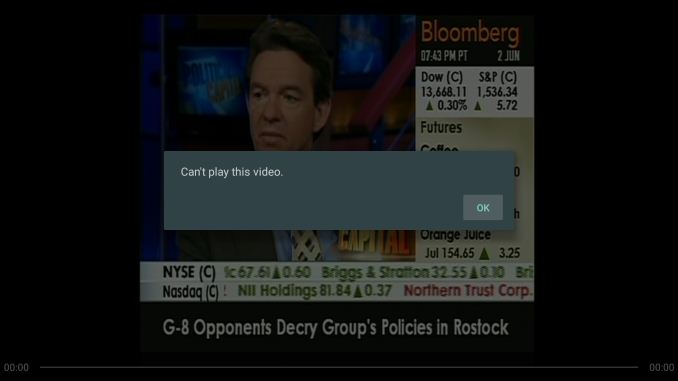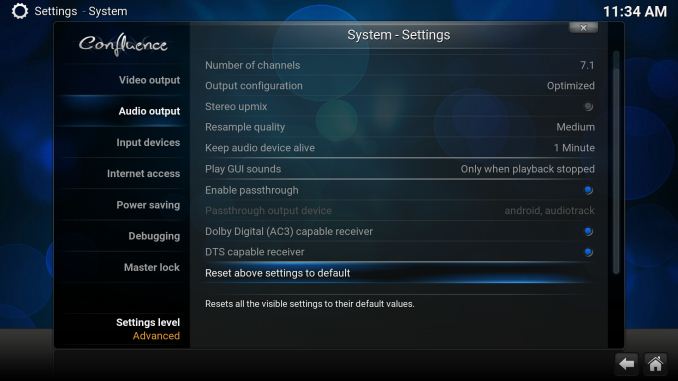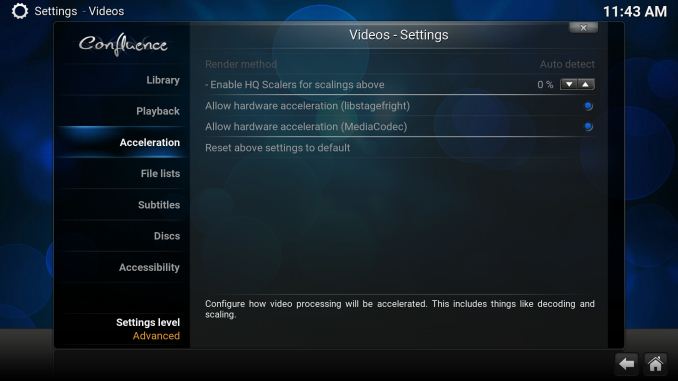The NVIDIA SHIELD Android TV Review: A Premium 4K Set Top Box
by Ganesh T S on May 28, 2015 3:00 PM EST- Posted in
- Media Streamer
- Home Theater
- TV
- 4K
- Shield
- NVIDIA
Local Media Playback Evaluation
The announcement of the SHIELD Android TV box generated a lot of interest amongst media streaming enthusiasts. It has continued to this date. Given that most of them prefer local media playback to OTT streaming, there has been marked interest in the local media playback capabilities of the unit. In this section, we attempt to set the expectations right on the various relevant aspects.
Display Refresh Rate
The Android TV framework forces the interface and most apps to run at 60 Hz. Obviously, a 24 fps film needs to be pulled-down with a 3:2 cadence to let the display be refreshed at 60 Hz. This creates a judder effect. Apps such as TVHZ were created to resolve this issue, but needs manual intervention prior to media playback. Kodi's currently existing 'sync refresh rate to playback frame rate' option doesn't work, but a fix is probably coming soon.
Codecs Licensing
Unlike a PC, the SHIELD Android TV is an embedded system. Therefore, codec support involves NVIDIA signing licensing deals. For example, support for Dolby Digital / Dolby Digital Plus requires deals with Dolby Laboratories, while DTS / DTS-HD support requires deals with DTS. On the video side, H.264 support, for example, requires a deal with MPEG-LA. Each of these deals ends up increasing the end cost for the consumer. In order to hit an acceptable price point while ensuring all necessary components for OTT streaming (SHIELD's primary market) are in place, NVIDIA has signed deals for the following audio/video codecs only:
- H.264
- H.265
- VP9
- Dolby Digital (Update: only bitstreaming, no internal decode to PCM)
- Dolby Digital Plus (Update: only bitstreaming, no internal decode to PCM)
This means that the native Android Video Player can only play back the above codecs (in addition to the free-to-decode / play ones such as PCM audio). This also means that the SHIELD Android TV will not be doing any HD audio bitstreaming in the near future unless things chance on the licensing front.
That said, players such as Kodi, MX Player etc. can opt to use pure software decoding when hardware decoding is not available. It is also possible for app vendors to purchase the license themselves and then work with NVIDIA to get hardware acceleration / support for that. For example, SiliconDust (the vendor behind HDHomeRun) is doing it with their Live TV app in order to get hardware decoding enabled for MPEG-2.
Attempting 480i60 MPEG-2 Playback with the Native Android Video Player
Video Post Processing
Deinterlacing and pull-down detection / IVTC are essential for watching certain live TV channels and other interlaced content. NVIDIA only guarantees video post processing for the licensed codecs that go through their hardwrae decoder. Third-party players will need to work with NVIDIA to ensure that any software decoded streams are correctly hooked up to the post-processing chain.
We tried processing the HQV Benchmark videos on the SHIELD to get an objective evaluation of the SHIELD's post-processing capabilities, but unfortunately the MPEG-2 encoded streams were not processed properly when decoded in software on Kodi.
Experimenting with Kodi
The Kodi 15.0 beta 1 APK is available for sideloading on to the SHIELD Android TV. On the bitstreaming side, we could only select DTS and Dolby Digital, and Kodi had no problems bitstreaming those streams.
We played back our test streams from a Samsung T1 portable SSD attached to the USB 3.0 port. HEVC streams played back with hardware acceleration inside the Kodi interface, but Kodi had trouble with TS files. For hardware-accelerated codecs, the power consumption at the wall was around 6 W. For software-decoded ones such as our 1080i60 VC-1 clip, the power consumption shot up to 11.5 W.
The SHIELD Android TV / Kodi combination has absolutely no trouble with the vanilla H.264 files that people usually rip their Blu-rays to. Fortunately, despite the lack of MPEG-2 and VC-1 licenses, Kodi's software decode is efficient enough to not cause frame drops. The absence of deinterlacing is an issue, but that should hopefully get resolved soon.
Based on our evaluation, the SHIELD Android TV is definitely not a comprehensive HTPC replacement - particularly from the local media playback viewpoint. That said, it does have support for all major OTT services and Live TV as well as future DVR capabilities (thanks to Android TV). For a certain set of users, it is possible that the SHIELD can replace their HTPC. However, one needs to remember that the unit is an embedded system with plenty of constraints and doesn't have the same openness and flexibility that a HTPC has to offer.













167 Comments
View All Comments
BrokenCrayons - Friday, May 29, 2015 - link
Tablets with Windows 8.1 are very nice, inexpensive devices that can play videos and do a lot of other useful things, including running the usual library of x86 Windows software. While I think it's nice that nv is working on stuff like this, it just doesn't compete at all in flexibility with even something like a HP Stream desktop (the cute little blue tupperware-looking PC they sell for about the same price as this thing). Okay, okay, so you can display stuff on a 4k screen, but those aren't common and a lot of people, myself included, don't even own an external screen and would never consider buying one because they don't want to be stuck in one place passively consuming pre-recorded media. That seems like such an obsolete concept.Yojimbo - Friday, May 29, 2015 - link
You either have a lot of extra money or live alone. What happens to the TV when you take the tablet away? Why pay for a screen, camera, battery, and shock resistance, etc., or deal with power throttling when you don't have to? Any tablet that can do what the Shield TV can do is going to cost a lot more than the Shield TV. Plus the Shield TV doesn't look like someone left a tablet lying around. This is selling for $200 with a controller. The Shield Tablet cost $300 without a controller and with less I/O connectivity.savagemike - Friday, May 29, 2015 - link
It also won't toast bread - which my toaster does just fine. So I too don't see the point.TheJian - Friday, May 29, 2015 - link
Not sure why this can't replace your HTPC when you can load OTHER players that can do the things you call shortcomings of the built-in player (like kodi, VLC, Powerdvd's android app). It seems to me you should be able to get around any shortcomings with other apps.I see you said VLC doesn't work that well on shield right now (what do you mean by this comment ?), but what about running something like powerdvd from the PC as noted to get around issues? The android app will accept streaming from local PC's running PowerDVD which plays everything this won't I think. Most people even pondering an HTPC already have a full PC in another room on the network so any shortcomings here should be covered by that I'd guess (including playing blurays etc).
Why wasn't the Intel device shown in more stuff? IE, gfxbench, pcmark, Basemark 2? IE why not thrown in the surface 3 for these which you already have the scores for?
http://www.anandtech.com/show/9219/the-surface-3-r...
Saves me from bouncing back and forth to see how badly Intel got killed ;) You had surface 3 pro scores too as shown, why leave them out? Manhattan offscreen 1080p shows Surface 3 pro at 29fps, why not include it when you already have those scores? You had PCmark scores for Surface3 pro also shown above. Are the work portions completely different? Are the other pcmark tests not able to run on surface 3 pro? Photo editing/video playback etc PCMark benchmarks don't work on them? You had all the gfxbench scores for both surface3 pro and regular also. I don't get why you put them in for some stuff, but exclude listing those in other tests when you had the data.
daggre - Friday, May 29, 2015 - link
1. It's too expensive. It needs to be $99 like the Apple TV was before they dropped the price to $69. I know that's a huge drop and it may not be possible with the current specs (yet) but it won't ever be successful if it's more than $100.2. It needs to play all Android games, and then play Android TV games really really well. It may already do this but it wasn't clear from the article. Any games nVidia makes should be for Android TV in general (i.e. "Controllers instead of touch") but should really shine on Shield. If anyone plays a game on a different Android TV they should say to themselves "I wish I had bought a Shield" so then those games become both guides to other developers of what their Android TV games should be like, but also become advertisements to gamers on any Android device that the game they are playing on their phone/tablet/other Android TV hardware would be a better experience on the Shield.
In the end, if they don't have really good 3rd party support this will fail. Only Apple is capable of pulling a success out of the air (Apple TV) without 3rd party offerings, and even they had to open up to Netflix, Hulu, HBO and the sports channels.
malooka - Saturday, May 30, 2015 - link
The Matricom MX2 Midnight is about 79.00 You can get a fly mote (like a Wii remote) it has two partitions one side for internet and gaming and the other side for KODI They have a newer versioin out but I like my model which is a little cheaper. The xbmx which is now KODI is the streaming side. I love this box. You can find it on amazon. http://www.amazon.com/s/ref=nb_sb_ss_sc_7_14?url=s...bernstein - Friday, May 29, 2015 - link
Seems a bit like a missed opportunity...- no HD bitstreaming, no legacy hardware decoding...
- pairing a GTX960 class GPU (8 SMM instead of two) with an octo-core A57 might feasible for a $300-350 price point. Especially if it could dualboot steam os...
hifiaudio2 - Friday, May 29, 2015 - link
It is being said that Nvidia is considering a Codec pack to add HD audio passthrough, VC-1, Mpeg2, etc in hardware.It was also said that Mpeg2 hardware is already on the device, but currently only activated when installing a program like the forthcoming Silicondust HDHomerun DVR program that just had a Kickstarter and will come out in a few months (alpha testing to start in June for the Kickstarter backers).
Go the the Nvidia forums and voice your opinion for the Codec to be released!!!
https://forums.geforce.com/default/topic/836487/sh...
douglord - Friday, May 29, 2015 - link
GGames - You say this has 10-bit color output and HDR capability. Do any consumer grade dGPUs have that (along with the HDMI 2.0a and HDCP needs). I'm really concerned about this for my next PC build. Any thought on how to build a UHD Blueray capable 4k HTPC?ganeshts - Saturday, May 30, 2015 - link
GTX 960 is your only option right now.Wait for a few more months.. other options should start coming out